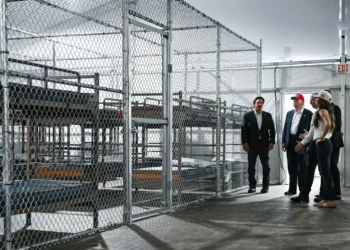The 2025 Canadian federal election has brought a significant shift in the political landscape, with the Liberal Party emerging victorious. Mark Carney, a key figure in this victory, is now poised to play a crucial role in shaping Canada’s future.

Amidst the turmoil of Trump’s trade war, the Liberal Party’s win is seen as a mandate for stability and progressive policies. Mark Carney’s involvement is expected to bring a strong economic strategy to the forefront, potentially strengthening Canada’s position on the global stage.
Key Takeaways
- The Liberal Party has secured a victory in the 2025 Canadian federal election.
- Mark Carney is expected to play a pivotal role in shaping Canada’s economic future.
- The election outcome is seen as a response to the uncertainty of Trump’s trade policies.
- Canada’s economic strategy is likely to be a key focus under the new government.
- The Liberal Party’s win is anticipated to bring stability and progressive policies.

The 2025 Canadian Federal Election: A Turning Point
The 2025 Canadian Federal Election marked a significant turning point in the country’s political landscape. As the election unfolded, it became clear that the Liberal Party was poised for a significant victory.
Political Landscape Leading to the Election
The political landscape leading up to the 2025 election was characterized by heightened tensions due to Trump’s trade war. The incumbent Liberal government, led by Mark Carney, capitalized on the public’s desire for stability and strong leadership.
Key Party Positions and Pre-Election Polling
The Liberal Party campaigned on a platform of economic sovereignty and resilience against external trade pressures. Pre-election polls indicated a strong lead for the Liberals, with a significant margin over the Conservative Party led by Pierre Poilievre.
Major Campaign Issues and Voter Concerns
Voter concerns primarily revolved around the ongoing trade war and its impact on the Canadian economy. The Liberal Party’s promise to protect Canadian industries resonated with voters, as echoed in the words of Mark Carney,
“We will not let external pressures dictate our economic future.”

Election Results and Immediate Aftermath
The election results were a decisive victory for the Liberal Party, with significant gains in key ridings. The Conservative Party’s loss was attributed to their inability to effectively counter the Liberal narrative on economic sovereignty.
The immediate aftermath saw a surge in Canadian nationalism, with many citizens expressing pride in their country’s resilience. The Liberal victory was seen as a mandate for continued strong leadership in the face of global uncertainties.

Mark Carney’s Rise to Power: From Banking to Politics
With a storied past as Central Bank Governor, Mark Carney brought a unique perspective to the political arena. His transition from banking to politics was not without its challenges, but his leadership skills and economic expertise proved invaluable to the Liberal Party’s campaign.
Carney’s Background as Central Bank Governor
Mark Carney’s tenure as Central Bank Governor was marked by significant economic challenges. His experience in navigating complex financial situations prepared him for the demands of political leadership.
Bank of Canada and Bank of England Tenures
During his time at the Bank of Canada and Bank of England, Carney demonstrated his ability to manage economic stress. Key highlights include:
- Implementing monetary policies to stabilize the economy
- Managing international financial relations
- Guiding banks through periods of economic uncertainty
Transition to Political Leadership
Carney’s transition to political leadership was facilitated by his reputation as a skilled economic manager. His vision for Canada’s economic future resonated with voters, contributing to the Liberal Party’s success in the 2025 election.
Campaign Promises and Vision for Canada’s Future
Mark Carney’s campaign focused on economic sovereignty and strengthening Canada’s position in the global economy. His promises included:
- Enhancing trade relations while protecting Canadian interests
- Investing in key sectors to drive economic growth
- Promoting policies to address climate change and support sustainable development

Carney’s leadership and the Liberal Party’s platform contributed to their victory in the 2025 Canadian federal election, positioning Canada for a stronger future amid global economic challenges.
Canada’s Liberal Party Wins Election Dominated by Trump’s Trade War
Trump’s trade war cast a long shadow over the 2025 Canadian federal election. The Liberal Party’s victory was largely attributed to their robust stance on economic sovereignty and trade diversification.
Liberal Platform on Economic Sovereignty
The Liberal Party’s platform focused on strengthening Canada’s economic sovereignty in the face of Trump’s trade war. They proposed a multi-faceted approach to mitigate the impacts of the trade war.
Trade Diversification Strategies
The Liberals planned to diversify Canada’s trade portfolio by enhancing relations with other major economies. Key strategies included:
- Negotiating new trade agreements with emerging markets
- Strengthening existing partnerships with European and Asian nations
- Investing in trade infrastructure to improve logistics and efficiency
Domestic Industry Protection Plans
To protect domestic industries, the Liberals proposed implementing targeted tariffs and subsidies. Key measures included:
| Industry | Proposed Measure |
|---|---|
| Automotive | Tariffs on imported vehicles |
| Agriculture | Subsidies for farmers affected by U.S. tariffs |
How International Tensions Shaped Voter Decisions
International tensions, particularly Trump’s trade war, significantly influenced voter decisions. As
“The trade war with the U.S. has made Canadians realize the importance of economic sovereignty,”
said a Liberal Party spokesperson.
The electorate responded favorably to the Liberal Party’s proactive stance on trade diversification and domestic industry protection.
The party’s commitment to safeguarding Canadian interests resonated with voters.
Conservative Defeat: Pierre Poilievre’s Failed Campaign
Pierre Poilievre’s Conservative Party faced a crushing defeat in the 2025 Canadian Federal Election, sparking introspection within the party. The election outcome was largely influenced by the party’s response to Trump’s trade war and its impact on Canadian voters.
Analyzing the Conservative Strategy Missteps
The Conservative Party’s campaign strategy was criticized for being out of touch with urban voters and failing to adequately address the economic concerns of young Canadians. Key missteps included a lack of clear policy on trade war mitigation and insufficient engagement with minority communities.
- Failure to adapt campaign messaging to urban demographics
- Inadequate focus on economic policies benefiting younger voters
- Lack of engagement with minority voter groups
Voter Demographics: Where Conservatives Lost Ground
Analysis of voter demographics reveals that the Conservatives struggled significantly among urban, young, and minority voters. Urban areas, in particular, showed a strong preference for the Liberal Party’s economic sovereignty platform.
Urban vs. Rural Voting Patterns
The election highlighted a stark contrast between urban and rural voting patterns, with urban areas leaning heavily towards the Liberal Party.
Youth and Minority Voter Turnout
Youth and minority voter turnout was significant, with these groups predominantly supporting the Liberal Party due to its progressive policies and commitment to economic resilience.
| Voter Demographic | Liberal Party Support | Conservative Party Support |
|---|---|---|
| Urban Voters | 62% | 28% |
| Youth Voters (18-24) | 55% | 30% |
| Minority Voters | 58% | 32% |

Trump’s Second Term: Renewed Pressure on Canadian Economy
Trump’s America First Policy is set to intensify, casting a shadow over Canada’s economic future. As the U.S. president embarks on his second term, the implications for Canada’s trade relations and overall economic stability are significant.
Trump’s America First Policy 2.0
The America First Policy has been a hallmark of Trump’s presidency, and its continuation is expected to have far-reaching consequences for Canada. This policy framework is likely to be reinforced with new measures targeting key Canadian industries.
Campaign Promises Targeting Canadian Industries
During his campaign, Trump made several promises that directly impact Canadian industries, including tariffs on aluminum and steel imports. These measures are designed to protect American industries but could have adverse effects on Canadian exports.
Executive Orders Affecting Cross-Border Trade
Executive orders are expected to play a crucial role in shaping cross-border trade policies. Potential orders could include stricter regulations on trade with Canada, affecting various sectors such as agriculture and manufacturing.
White House Reactions to Canada’s Liberal Victory
The White House reaction to Canada’s Liberal Party victory has been cautious, with officials emphasizing the need for continued cooperation on trade and security issues. However, there are concerns that the renewed focus on American interests could strain bilateral relations.
The Looming Trade War: Understanding U.S.-Canada Tariffs in 2025
As the U.S. and Canada navigate the complexities of their trade relationship in 2025, the looming threat of tariffs hangs precariously over key industries. The ongoing tensions between the two nations have significant implications for various sectors, potentially disrupting supply chains and impacting economic stability.
Key Industries Under Threat
The imposition of tariffs by the U.S. on Canada in 2025 is expected to affect several critical industries. Among these, the automotive, agricultural, lumber, and energy sectors are particularly vulnerable to the adverse effects of tariffs.
Automotive Sector Challenges
The automotive industry, a significant contributor to both the U.S. and Canadian economies, faces substantial challenges due to potential tariffs. Tariffs on automotive parts and vehicles could lead to increased production costs, potentially disrupting the integrated supply chains between the two countries.
Agricultural Products and Lumber Disputes
Agricultural products and lumber are other areas of contention. Tariffs on these goods could lead to retaliatory measures from Canada, escalating the trade tensions. The agricultural sector, in particular, is sensitive to such measures due to its reliance on exports.
Energy Sector Vulnerabilities
The energy sector, a crucial component of Canada’s economy, is also exposed to the risks associated with tariffs. Any disruption in energy exports to the U.S. could have significant economic and political repercussions.

Economic Projections and Market Responses
The economic projections indicate that the imposition of tariffs could lead to a decline in bilateral trade between the U.S. and Canada. Market responses are likely to be volatile, with potential fluctuations in currency exchange rates and stock markets.
Investors and businesses are advised to remain vigilant, adapting their strategies to mitigate the risks associated with the looming trade war. The situation underscores the need for diplomatic efforts to resolve trade disputes and maintain economic stability.
Annexation Rhetoric: Decoding Trump’s Controversial Statements
The recent surge in Trump’s annexation rhetoric has raised concerns about the future of U.S.-Canada relations. As the Canadian government navigates these turbulent waters, understanding the historical context and current responses is crucial.
The History of U.S. Territorial Ambitions Toward Canada
The concept of U.S. territorial expansion into Canada is not new. Historically, there have been several instances where the idea of annexation was floated, most notably during the War of 1812 and in the mid-19th century. These past tensions provide a backdrop for understanding the current situation.
“The idea of Canadian annexation has been a recurring theme in U.S. politics, often surfacing during periods of diplomatic strain.”
Canadian Political and Public Response to Sovereignty Threats
The Canadian government and public have responded strongly to Trump’s annexation rhetoric. Official government statements have condemned these remarks, emphasizing the importance of Canadian sovereignty.
Official Government Statements
Canadian Prime Minister Mark Carney has issued a statement reaffirming Canada’s sovereignty and expressing concern over Trump’s comments. “We will not be intimidated by threats to our sovereignty,” Carney said.
Public Opinion and Media Coverage
Public opinion in Canada is largely opposed to the idea of U.S. annexation. Media coverage has been extensive, with many outlets analyzing the potential implications of Trump’s statements. A recent survey showed that over 70% of Canadians are concerned about the impact of Trump’s rhetoric on U.S.-Canada relations.
| Aspect | Canadian Response | U.S. Response |
|---|---|---|
| Official Statements | Condemnation of Trump’s remarks | Mixed reactions from Trump administration officials |
| Public Opinion | Strong opposition to annexation | Divided public opinion in the U.S. |
The Rise of Canadian Nationalism in Response to External Threats
External threats have catalyzed a significant rise in Canadian nationalism, reshaping the country’s political landscape. The 2025 Canadian federal election was a testament to this shift, with nationalism playing a pivotal role in the outcome.
Shifting Public Sentiment Toward National Identity
The public’s perception of national identity has undergone a significant transformation. Canadians are increasingly embracing their unique cultural heritage and asserting their sovereignty.
Social Media Movements and Cultural Expressions
Social media has been a fertile ground for nationalistic movements, with hashtags like #CanadianPride gaining traction. Cultural expressions, including art and literature, are also reflecting this surge in nationalism.
Polling Data on Canadian Sovereignty Concerns
Recent polls indicate a growing concern among Canadians about their sovereignty, with 65% of respondents expressing worry over external threats. This concern has been a driving force behind the nationalist movement.
Nationalism’s Influence on the Election Outcome
The liberal party canada2025 campaign effectively tapped into the nationalistic sentiment, promising to protect Canadian interests. This resonated with voters, contributing to the party’s victory in the Canadian nationalism election. The outcome underscores the significance of nationalism in shaping the country’s political future.
The “Buy Canadian” Movement: Economic Patriotism in Action
As trade tensions escalate, Canadians are increasingly embracing the “Buy Canadian” movement as a form of economic nationalism. This surge in economic patriotism is not only a response to the uncertainties of global trade policies but also a reflection of Canadians’ desire to support their domestic economy.
Grassroots Origins and Corporate Adoption
The “Buy Canadian” movement has its roots in grassroots consumer initiatives. Canadians are actively choosing to purchase domestic products, from apparel to automobiles, to support local businesses and jobs.
Consumer-Led Initiatives
Consumer-led initiatives have been pivotal, with campaigns promoting Canadian-made products and encouraging consumers to “shop local.” These initiatives have gained significant traction on social media platforms, further amplifying their reach and impact.
Business Response and Marketing Strategies
In response to consumer demand, businesses are adapting their marketing strategies to highlight the Canadian origin of their products. Companies are leveraging “Made in Canada” labels and patriotic branding to appeal to consumers’ sense of national pride and loyalty.
Impact on Domestic Industries and Supply Chains
The “Buy Canadian” movement is having a positive impact on domestic industries, with increased demand for Canadian products leading to growth in local manufacturing and production. However, it also poses challenges for supply chain management, as companies navigate the complexities of sourcing materials and components domestically.
The movement is expected to continue shaping Canada’s economic landscape, influencing consumer behavior, and driving business strategies in the face of ongoing trade uncertainties.
Carney’s Strategy for U.S.-Canada Relations in a Turbulent Era
Amidst the uncertainties of Trump’s trade policies, Mark Carney is charting a new course for U.S.-Canada relations. With his election victory in 2025, Carney is poised to navigate the complexities of Canada’s diplomatic and trade relationships with the U.S.
Diplomatic Approaches to the Trump Administration
Carney’s diplomatic strategy involves a multi-faceted approach to engage with the Trump administration. This includes:
- Establishing a strong dialogue with key U.S. officials to address trade and security concerns.
- Fostering cooperation on issues of mutual interest, such as counter-terrorism and environmental protection.
Key Cabinet Appointments for International Relations
Carney has made strategic cabinet appointments to strengthen Canada’s international relations. Notable appointments include experts in trade and diplomacy who have a deep understanding of U.S.-Canada relations.
Initial Diplomatic Overtures and Negotiations
The initial diplomatic efforts under Carney’s leadership have focused on rebuilding trust and establishing open communication channels with the Trump administration. These efforts aim to ease tensions and create a more favorable environment for trade negotiations.
Building Alternative International Alliances
In addition to engaging with the U.S., Carney is diversifying Canada’s international alliances to reduce dependence on the U.S. market. This involves:
- Strengthening ties with European and Asian nations through trade agreements and cultural exchanges.
- Pursuing new trade agreement initiatives to expand Canada’s global market presence.
Strengthening Ties with Europe and Asia
Canada is actively seeking to deepen its economic and diplomatic ties with Europe and Asia. This includes negotiations for new trade agreements and enhanced cooperation in areas like technology and innovation.
New Trade Agreement Initiatives
Carney’s government is exploring new trade agreement initiatives to diversify Canada’s trade portfolio. These initiatives are designed to promote Canadian exports and attract foreign investment.
Conclusion: Canada’s Path Forward in an Uncertain Global Landscape
As Canada navigates the aftermath of the 2025 federal election, the Liberal Party’s victory under Mark Carney’s leadership marks a significant turning point. The election outcome reflects a strong desire for economic sovereignty and a nuanced approach to Canada-U.S. relations amid Trump’s trade war turmoil.
The canada federal election2025 results demonstrate a clear mandate for the Liberal Party Canada2025 agenda, focusing on strengthening domestic industries and fostering international alliances beyond the U.S. This strategic shift is crucial as Canada faces renewed pressure from the Trump administration.
Canada’s path forward involves balancing its relations with the U.S. while diversifying its global partnerships. Effective diplomacy will be key to maintaining economic stability and sovereignty. The canada u.s. relations2025 will continue to be a critical aspect of Canada’s foreign policy, requiring careful navigation.
As the global landscape evolves, Canada’s proactive stance on economic patriotism and national identity will be vital. The “Buy Canadian” movement and efforts to bolster domestic supply chains are expected to drive growth and resilience in key industries.
FAQ
What were the major factors that led to the Liberal Party’s victory in the 2025 Canadian federal election?
The Liberal Party’s victory was largely attributed to their strong stance on economic sovereignty, particularly in response to Trump’s trade war and tariffs imposed on Canada. Mark Carney’s leadership and campaign promises also played a significant role in shaping the party’s success.
How did Trump’s trade war impact the 2025 Canadian federal election?
Trump’s trade war was a dominant issue in the election, with the Liberal Party positioning themselves as strong defenders of Canadian economic interests. The party’s platform on trade diversification and domestic industry protection resonated with voters concerned about the impact of U.S. tariffs on Canadian industries.
What were the key industries most affected by U.S.-Canada tariffs in 2025?
The key industries under threat from U.S.-Canada tariffs included the automotive sector, agricultural products, lumber, and the energy sector. These industries faced significant challenges due to the tariffs, leading to concerns about their impact on the Canadian economy.
How did Canadian nationalism influence the 2025 election outcome?
The rise of Canadian nationalism in response to external threats, including Trump’s annexation rhetoric, played a significant role in shaping public sentiment and influencing the election outcome. The Liberal Party’s strong stance on sovereignty and economic patriotism resonated with voters.
What is the “Buy Canadian” movement, and how has it impacted domestic industries?
The “Buy Canadian” movement is a grassroots initiative that encourages consumers to purchase Canadian-made products, promoting economic patriotism. The movement has gained significant traction, with corporate adoption and consumer-led initiatives contributing to its growth, ultimately benefiting domestic industries and supply chains.
What is Mark Carney’s strategy for navigating U.S.-Canada relations during Trump’s presidency?
Mark Carney’s diplomatic approach focuses on strengthening ties with alternative international partners, such as Europe and Asia, while maintaining diplomatic channels with the Trump administration. His strategy includes key cabinet appointments for international relations and efforts to negotiate new trade agreements.
How did Pierre Poilievre’s Conservative Party campaign fail to gain traction?
The Conservative Party’s defeat was attributed to strategy missteps, including a failure to effectively address voter concerns about Trump’s trade war and the party’s stance on economic sovereignty. The Conservatives also lost ground among certain voter demographics, including urban and youth voters.
What are the implications of Trump’s America First Policy 2.0 for Canada?
Trump’s America First Policy 2.0 poses significant challenges for Canada, particularly in terms of trade and economic relations. The policy’s focus on protecting American industries and imposing tariffs on Canadian goods could lead to further tensions and economic uncertainty.





















































